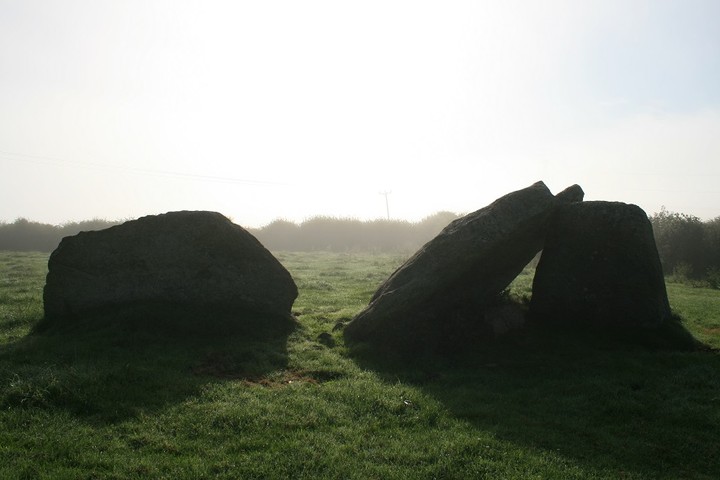I was pretty determined to spend ‘Christmas Day’ 2002 on a wind swept moor amongst ancient sites, and I managed to do just that.
I started with a quiet drive to the most famous quoit in East Cornwall, the huge Trethevy Quoit. I had seen it so many times in pictures; it was great to see it for real.
I moved onto toward the Hurlers but not before stopping at The Longstone Cross / Long Tom Cross. It may have once been a menhir that was then Christianised by carving a cross on its face. The stone stands alone, often amongst sheep roaming the moor, and on the horizon a line of old mine chimneys can been seen, marking the lode (course) of a copper vein. Even on this day there were lots of walkers and doggie people around The Hurlers, which was nice. It’s good to see people taking an interest (even a passing interest) in our history. Not only are the circles fascinating, but the whole place is steeped in history, from the Pipers, Rillaton Barrow, the Cheesewring, Stowe’s Pound, and Craddock moor sites, to the plethora of old mining ruins.
Without a map or compass you may be lucky enough to stagger across the fallen Craddock Moor Circle 1 km North West of the Hurlers whilst exploring Craddock Moor. Even with a map and compass you may not find them as the stones are all recumbent and are not visible from any distance. Further on is the tiny Craddock Moor Stone Row. There’s no easy way to describe how to get to this but if you wanna go try my instructions (or practice better compass reading that me – not hard!).
A few kilometres away from the Hurlers area, King Doniert’s Stone(s) stand in a beautiful walled enclosure, complete with stone benches. The Cornwall Heritage Trust could obviously teach English Heritage a thing or two.
I love ancient sites but sometimes you need a break so I went to the Eden Project on the 26th. This is not a criticism but of all the people who needed to go I wasn’t high on the list – I live a few kilometres from Kew Gardens and they are pretty similar in many ways. Anyway, go and see, and if you do, please spend a minute filling in a Gift Aid form, which means that they can claim 28% extra (over and above your admission fee) from the taxman.
On my way to Bodmin Moor I stopped at Lesquite Quoit but couldn’t properly explore, and had a wander around the huge Lanhydrock estate. The rest of the day was spent on the moor visiting the three stone circles of Stannon, Louden Hill, and Fernacre. Many of my stone counts didn’t match other people’s counts, the most interesting of which may have been Louden Hill where I counted 31 stones, as opposed to Craig Weatherhill’s 16/17 stones.
I also stumbled across something that could be interesting, or could just be a few stones in a quarter circle – I’ve taken the liberty of calling it Louden Hill 2?? I take no responsibility for it being just a couple of stones spotted by an eccentric walker on a lonely moor! I also came across a stone cist and two cairns between Louden Hill and Fernacre, which all seemed to align East-West to a stone in the background. As the night descended it led to the photos coming out very dark and now I scratch my head and wonder if it was just my imagination……a strange day.







































































































































